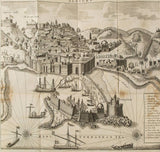A Compleat History of the Piratical States of Barbary viz. Aglers, Tunis, Tripoli and Morocco. Containing The Origin, Revolutions and prefent State of the Kingdom, their Forces, Revenues, Policy and Commerce
Author: Jacques Philippe Laugier of Tassy (?-1748)
Year: 1750
Publisher: Printed for R Griffiths
Place: London
Description:
xiv+368 pages with one folding map and folding plan. Octavo (8" x 5") bound in full leather with five raised spine bands and red label in gilt lettering to spine and gilt decorative cover with gilt spine ends. translated by Joseph Morgan. (Querard, IV, 614 - Playfair,° 220 - Chadenat,° 896) later edition first published in English in 1725.
This work is an influential description of Algeria, first published in 1725 in French, and expanded here with a detailed list of 73 Dutch ships captured by Algerian pirates. Algeria was at this time nominally ruled by the Ottoman Empire, but retained a great deal of independence in practice. The work begins with a description of the various inhabitants, including separate chapters on the Arabic and Turkish populations, followed by chapters on its architecture, military, navy, politics, slavery, trade etc. It was written by the Jacques Philippe Laugier de Tassy, a former diplomat in Algeria and at this date commissioner of the French navy and consul in the Netherlands. It was translated into English as A complete history of the piratical states of Barabry, a title that emphasized the notorious Algerian pirates. "Barbary" was not always a unified political entity. From the 16th century on wards, it was divided into the political entities of the Regency of Algiers, Tunis, and Tripolitania (Tripoli). Major rulers during the times of the Barbary states' plundering parties included the Pasha or Dey of Algiers, the Bey of Tunis and the Bey of Tripoli. Before then, the territory was usually divided between Ifriqiya, Morocco, and a west-central Algerian state centered on Tlemcen or Tiaret. Powerful Berber dynasties such as the Almohads (12th century) and briefly thereafter the Hafsids, occasionally unified it for short periods. From a European perspective its "capital" or chief city was often considered to be Tripoli in modern-day Libya, although Marrakesh in Morocco was the largest and most important Berber city at the time. In addition, Algiers in Algeria and Tangiers in Morocco were also sometimes seen as the "capital".
Condition:
folding plate with neat repairs, contemporary calf, gilt, upper joint repaired but splitting again, lower joint tender, spine a little rubbed with slight loss to extremities else about a very nice copy.
Year: 1750
Publisher: Printed for R Griffiths
Place: London
Description:
xiv+368 pages with one folding map and folding plan. Octavo (8" x 5") bound in full leather with five raised spine bands and red label in gilt lettering to spine and gilt decorative cover with gilt spine ends. translated by Joseph Morgan. (Querard, IV, 614 - Playfair,° 220 - Chadenat,° 896) later edition first published in English in 1725.
This work is an influential description of Algeria, first published in 1725 in French, and expanded here with a detailed list of 73 Dutch ships captured by Algerian pirates. Algeria was at this time nominally ruled by the Ottoman Empire, but retained a great deal of independence in practice. The work begins with a description of the various inhabitants, including separate chapters on the Arabic and Turkish populations, followed by chapters on its architecture, military, navy, politics, slavery, trade etc. It was written by the Jacques Philippe Laugier de Tassy, a former diplomat in Algeria and at this date commissioner of the French navy and consul in the Netherlands. It was translated into English as A complete history of the piratical states of Barabry, a title that emphasized the notorious Algerian pirates. "Barbary" was not always a unified political entity. From the 16th century on wards, it was divided into the political entities of the Regency of Algiers, Tunis, and Tripolitania (Tripoli). Major rulers during the times of the Barbary states' plundering parties included the Pasha or Dey of Algiers, the Bey of Tunis and the Bey of Tripoli. Before then, the territory was usually divided between Ifriqiya, Morocco, and a west-central Algerian state centered on Tlemcen or Tiaret. Powerful Berber dynasties such as the Almohads (12th century) and briefly thereafter the Hafsids, occasionally unified it for short periods. From a European perspective its "capital" or chief city was often considered to be Tripoli in modern-day Libya, although Marrakesh in Morocco was the largest and most important Berber city at the time. In addition, Algiers in Algeria and Tangiers in Morocco were also sometimes seen as the "capital".
Condition:
folding plate with neat repairs, contemporary calf, gilt, upper joint repaired but splitting again, lower joint tender, spine a little rubbed with slight loss to extremities else about a very nice copy.















